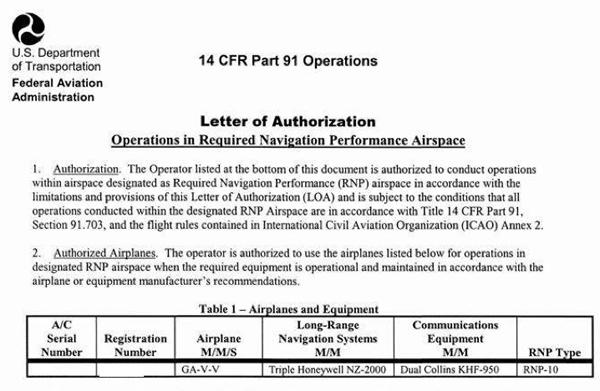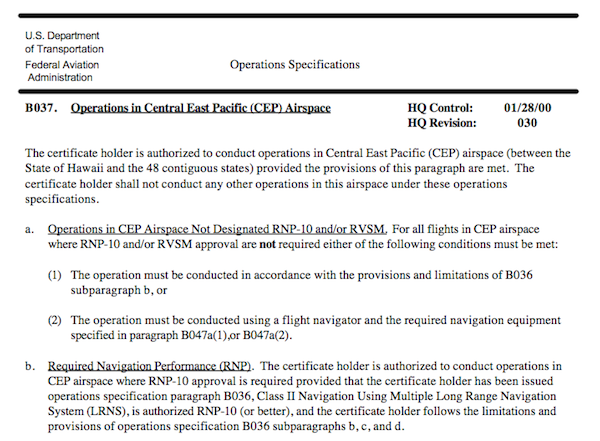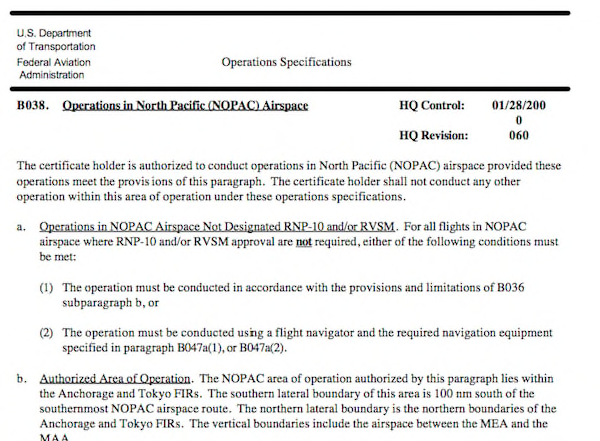Required Navigation Performance (RNP) standards are almost always performance based, requiring on-board performance monitoring and alerting. This is as opposed to the older RNAV systems which are an equipment-based standard that do not require on-board performance monitoring and alerting.
— James Albright

Updated:
2020-12-14
We say almost always because RNP-10 is an exception. Many areas of the world adopted "RNP-10" as synonymous with "RNAV-10," violating the method ICAO set up in ICAO Doc 9613 Performance Based Navigation. The ICAO elected to retain "RNP-10" when in fact it meant "RNAV-10" because changing all the charts and manuals would have been too expensive. The key takeaway from all this is to realize that "RNP-10" does not require performance monitoring and alerting, as do the other RNP designations.
Under 14 CFR 91 you will need an LOA and under 14 CFR 135 you will need OpSpecs B037 and B038.
1 — Inconsistent RNP designation
3 — Accuracy / performance standards

1
Inconsistent RNP designation
The existing RNP 10 designation is inconsistent with PBN RNP and RNAV specifications. RNP 10 does not include requirements for on-board performance monitoring and alerting. For purposes of consistency with the PBN concept, RNP 10 is referred to as RNAV 10 in this manual. Renaming current RNP 10 routes, operational approvals, etc., to an RNAV 10 designation would be an extensive and expensive task, which is not cost-effective. Consequently, any existing or new operational approvals will continue to be designated RNP 10, and any charting annotations will be depicted as RNP 10.
Source: ICAO Doc 9613, Volume I, Part A, ¶1.2.5.1
2
Location
Africa
For flights on designated controlled oceanic routes or areas within the Canarias FIR (southern sector), Dakar Oceanic, Recife and Sal Oceanic FIRs, and on designated routes over continental Africa, a lateral separation minimum of 93 km (50 NM) may be applied.
For flights in the EUR/SAM corridor (Canarias (southern sector), Dakar Oceanic, Recife and Sal Oceanic FIRs), a longitudinal separation minimum of 93 km (50 NM) derived by RNAV may be applied between RNAV-equipped aircraft approved to RNP 10 or better, in accordance with the provisions of the PANS-ATM, 5.4.2.6.
Source: ICAO Doc 7030, §AFI, ¶4.1.1
PANS-ATM require direct controller-pilot communications and a position report every 24 minutes.
Longitudinal distance-based separation minima of 93 km (50 NM) between RNAV aircraft on the same track on RNP 10 routes over continental Africa shall not be used.
Source: ICAO Doc 7030, §AFI, ¶4.1.1
Asia
For flights on designated controlled oceanic routes or areas within the Auckland Oceanic, Brisbane, Fukuoka, Honiara, Melbourne, Nauru, New Zealand and Port Moresby FIRs, a lateral separation minimum of 93 km (50 NM) may be applied.
For flights on designated controlled oceanic routes or areas within the Auckland Oceanic, Brisbane, Fukuoka, Honiara, Melbourne, Nauru, New Zealand and Port Moresby FIRs, a longitudinal separation minimum of 93 km (50 NM) derived by RNAV may be applied between RNAV-equipped aircraft approved to RNP 10 or better, in accordance with the provisions of the PANS-ATM, 5.4.2.6.
Source: ICAO Doc 7030, §MID/ASIA, ¶4.1.1
PANS-ATM require direct controller-pilot communications and a position report every 24 minutes.
Pacific
For flights on designated controlled oceanic routes or areas within the Anchorage Arctic, Anchorage Continental, Anchorage Oceanic, Auckland Oceanic, Nadi, Oakland Oceanic and Tahiti FIRs, a lateral separation minimum of 93 km (50 NM) may be applied.
For flights on designated controlled oceanic routes or areas within the Anchorage Arctic, Anchorage Continental, Anchorage Oceanic, Auckland Oceanic, Nadi, Oakland Oceanic and Tahiti FIRs, a longitudinal separation minimum of 93 km (50 NM) derived by RNAV may be applied between RNAV-equipped aircraft approved to RNP 10 or better, in accordance with the provisions of the PANS-ATM, 5.4.2.6.
Source: ICAO Doc 7030, §PAC, ¶4.1.1
PANS-ATM require direct controller-pilot communications and a position report every 24 minutes.
South America
For flights on designated controlled oceanic routes or areas within the Canarias FIR (southern sector), Dakar Oceanic, Recife and Sal Oceanic FIRs a lateral separation minimum of 93 km (50 NM) may be applied.
For flights in the EUR/SAM corridor (Canarias (southern sector), Dakar Oceanic, Recife and Sal Oceanic FIRs), a longitudinal separation minimum of 93 km (50 NM) derived by RNAV may be applied between RNAV-equipped aircraft approved to RNP 10 or better, in accordance with the provisions of the PANS-ATM, 5.4.2.6.
Source: ICAO Doc 7030, §SAM, ¶4.1.1
PANS-ATM require direct controller-pilot communications and a position report every 24 minutes.
RNAV Provisions
LONGITUDINAL SEPARATION MINIMA BASED ON DISTANCE USING RNAV WHERE RNP IS SPECIFIED
5.4.2.6.2.2 Direct controller-pilot communications shall be maintained while applying a distance-based separation minima. Direct controller-pilot communications shall be voice or CPDLC. The communication criteria necessary for CPDLC to satisfy the requirement for direct controller-pilot communications shall be established by an appropriate safety assessment.
5.4.2.6.3 Longitudinal distance-based separation minima in an RNP RNAV environment not using ADS
5.4.2.6.3.1 For aircraft cruising, climbing or descending on the same track, the following separation minimum may be used:
| Separation minimum | RNP type | Communication requirement | Surveillance requirement | Distance verification requirements |
| 93 km (50NM) | 10 | Direct controller-pilot communications | Procedure position reports | At least every 24 minutes |
5.4.2.9.2 The following separation minima may be used for aircraft cruising, climbing or descending on:
a) the same track; or
b) crossing tracks provided that the relative angle between the tracks is less than 90 degrees.
| Separation minimum | RNP type | RCP | RSP | Maximum ADS periodic reporting interval |
| 93 km (50NM) | 10 | 240 | 180 | 27 minutes |
| 93 km (50NM) | 4 | 240 | 180 | 32 minutes |
| 55.5 km (30NM) | 2 or 4 | 240 | 180 | 12 minutes |
| 5 minutes | 2 or 4 or 10 | 240 | 180 | 14 minutes |
Source: ICAO Doc 4444, ¶5.4.2.6
If you do not have ADS and are not RNP-4 authorized, the controllers have the option of accepting you but using increased separation standards provided: you are RNP-10 qualified, you are in direct communications with the controller, and the controller has the capability of intervening within 4 minutes.
3
Accuracy / performance standards
- Accuracy: During operations in airspace or on routes designated as RNP 10, the lateral total system error must be within ±10 NM for at least 95 per cent of the total flight time. The along-track error must also be within ±10 NM for at least 95 per cent of the total flight time.
- Integrity: Malfunction of the aircraft navigation equipment is classified as a major failure condition under airworthiness regulations (i.e. 10–5 per hour).
- Continuity: Loss of function is classified as a major failure condition for oceanic and remote navigation. The continuity requirement is satisfied by the carriage of dual independent LRNSs (excluding signal-in-space).
- Signal-in-space: If using GNSS, the aircraft navigation equipment shall provide an alert if the probability of signal-in- space errors causing a lateral position error greater than 20 NM exceeds 10–7 per hour.
Note 1.— For RNP 10, operational approval of aircraft capable of coupling the area navigation (RNAV) system to the flight director or autopilot, a navigational positioning error is considered to be the dominant contributor to cross-track and along-track error. Flight technical error, path definition error and display errors are considered to be insignificant for the purposes of RNP 10 approval.
Note 2.— When the data collection method described in Appendix 1 of FAA Order 8400.12A (as amended) is used as the basis for an RNP 10 operational approval, these error types are included in the analysis. However, when the data collection method described in Appendix 6 of FAA Order 8400.12A is used, these errors are not included since that method is more conservative. The Appendix 6 method uses radial error instead of cross-track and along-track error.
Source: ICAO Doc 9613, Volume II, Part B,¶1.3.4.1
4
Documentation / certification
Determining Eligibility of Aircraft
Manufacturers should evaluate their systems against these criteria and document the Required Navigation Performance (RNP) capabilities as per guidance in the current editions of AC 90-105, Approval Guidance for RNP Operations and Barometric Vertical Navigation in the U.S. National Airspace System and in Oceanic and Remote Continental Airspace, and AC 20-138, Airworthiness Approval of Positioning and Navigation Systems.
Source: FAA Order 8900.1, Vol 3, Ch 18, §4, ¶B036.E.
Operational Approval - 14 CFR 91
- 7.1 Part 91 Operators. A letter of authorization (LOA) is not required for Title 14 of the Code of Federal Regulations (14 CFR) part 91 operators (other than part 91 subpart K (part 91K)) except for oceanic operations (see Appendices E, F, and G) or if required in foreign airspace. Part 91 operators (other than 91K) should comply with the aircraft eligibility and operational guidance in this advisory circular (AC).
- 7.2 Operational Authorization. To obtain operational authorization, aircraft eligibility must be determined in accordance with the applicable appendix of this AC. Operational authorizations issued under a previous version of this AC or other canceled ACs does not need to be reissued or reevaluated.
Note: Previous approvals under FAA Order 8400.12C, Required Navigation Performance 10 (RNP 10) Operational Authorization, and FAA Order 8400.33, Procedures for Obtaining Authorization for Required Navigation Performance 4 (RNP-4) Oceanic and Remote Area Operations, are still valid for these operations. Operators must ensure their operations remain consistent with the performance and functional requirements of this AC.
Source: AC 90-105A
Operational Approval - 14 CFR 91K, 121, 125, 129, and 135
Parts 91K, 121, 125, 129, and 135 Operators. Title 14 CFR parts 91K, 121, 125, 129, and 135 operators receive approval to fly RNP operations as described in this AC via operations specifications (OpSpecs), management specifications (MSpecs), or LOAs as follows:
- OpSpec/MSpec/optional LOA, paragraph C063, Area Navigation (RNAV) and Required Navigation Performance (RNP) Terminal Operations;
- OpSpec/MSpec, paragraph B035, Class 1 Navigation in U.S. Class A Airspace Using Area or Long-Range Navigation Systems;
- OpSpec/MSpec/LOA (to include Part 91 operators), paragraph B036, Oceanic and Remote Continental Navigation Using Multiple Long-Range Navigation Systems (M-LRNS); or
- Helicopter Specification (HSpec)/LOA, paragraph H123, Class I Navigation Using Area or Long-Range Navigation Systems with Wide Area Augmentation System (WAAS) for Rotorcraft Required Navigation Performance (RNP) 0.3 En Route and Terminal Operations.
Source: AC 90-105A
References
(Source material)
FAA Order 8900
ICAO Doc 4444, Amendment 9 to the PANS-ATM, 15 June 2020
ICAO Doc 7030 - Regional Supplementary Procedures, International Civil Aviation Organization, 2008
ICAO Doc 9613 - Performance Based Navigation (PBN) Manual, International Civil Aviation Organization, Fourth Edition, 2013


